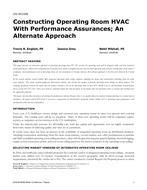Software is making an impact on the design and deployment of efficient fenestration products by making performance ratings widely available. Such ratings have influenced codes and aided voluntary market transformation programs. Software tools developed to date have focused on determining product properties, such as the solar heat gain coefficient (SHGC), U-factor, and visible transmittance. However, to fully realize the potential for energy savings from fenestration products, software needs to be improved in the following three key areas:
1. modeling of fenestration product details since, for highly efficient products with low heat flow, these details become the significant areas for improving performance;
2. quantifying the relationship between energy efficiency and the more important non-energy benefits, such as thermal and visual comfort and condensation; and
3. linking applications level tools (which consider the building and location where the fenestration product will be installed) to fenestration product modeling tools for users to understand how specific products perform in specific buildings under particular installation conditions.
This paper addresses how future window modeling software can–and needs to–address these three topical areas in order to help promote the development of efficient window products and their effective use.
Authors: Dariush K. Arasteh, P.E.; Robin D. Mitchell; Christian Kohler; Charlie Huizenga; Dragan C. Curcija, Ph.D.
Citation: Thermal Performance of the Exterior Envelopes of Buildings VIII
Keywords: December, Florida, 2001
Citation: Thermal Performance of the Exterior Envelopes of Whole Buildings VIII
Product Details
- Published:
- 2001
- File Size:
- 1 file , 24 MB
- Product Code(s):
- D-7979


